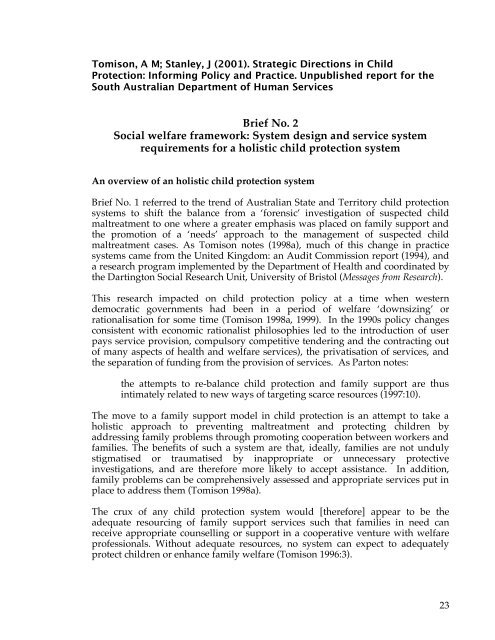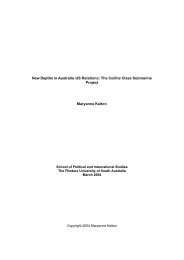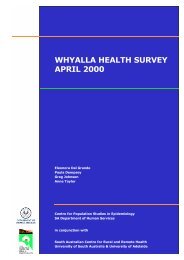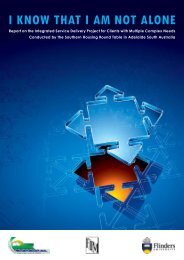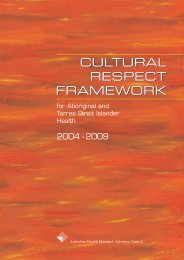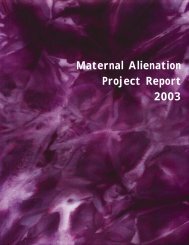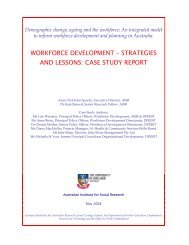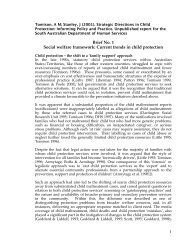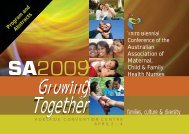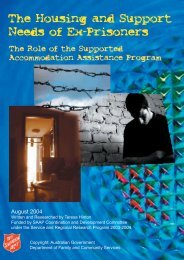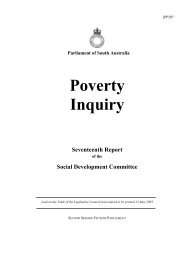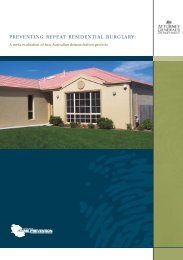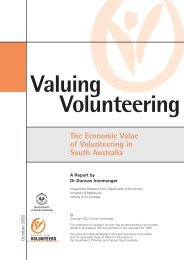Brief No. 2 Social welfare framework - Australian Institute of Family ...
Brief No. 2 Social welfare framework - Australian Institute of Family ...
Brief No. 2 Social welfare framework - Australian Institute of Family ...
Create successful ePaper yourself
Turn your PDF publications into a flip-book with our unique Google optimized e-Paper software.
Tomison, A M; Stanley, J (2001). Strategic Directions in Child<br />
Protection: Informing Policy and Practice. Unpublished report for the<br />
South <strong>Australian</strong> Department <strong>of</strong> Human Services<br />
<strong>Brief</strong> <strong>No</strong>. 2<br />
<strong>Social</strong> <strong>welfare</strong> <strong>framework</strong>: System design and service system<br />
requirements for a holistic child protection system<br />
An overview <strong>of</strong> an holistic child protection system<br />
<strong>Brief</strong> <strong>No</strong>. 1 referred to the trend <strong>of</strong> <strong>Australian</strong> State and Territory child protection<br />
systems to shift the balance from a ‘forensic’ investigation <strong>of</strong> suspected child<br />
maltreatment to one where a greater emphasis was placed on family support and<br />
the promotion <strong>of</strong> a ‘needs’ approach to the management <strong>of</strong> suspected child<br />
maltreatment cases. As Tomison notes (1998a), much <strong>of</strong> this change in practice<br />
systems came from the United Kingdom: an Audit Commission report (1994), and<br />
a research program implemented by the Department <strong>of</strong> Health and coordinated by<br />
the Dartington <strong>Social</strong> Research Unit, University <strong>of</strong> Bristol (Messages from Research).<br />
This research impacted on child protection policy at a time when western<br />
democratic governments had been in a period <strong>of</strong> <strong>welfare</strong> ‘downsizing’ or<br />
rationalisation for some time (Tomison 1998a, 1999). In the 1990s policy changes<br />
consistent with economic rationalist philosophies led to the introduction <strong>of</strong> user<br />
pays service provision, compulsory competitive tendering and the contracting out<br />
<strong>of</strong> many aspects <strong>of</strong> health and <strong>welfare</strong> services), the privatisation <strong>of</strong> services, and<br />
the separation <strong>of</strong> funding from the provision <strong>of</strong> services. As Parton notes:<br />
the attempts to re-balance child protection and family support are thus<br />
intimately related to new ways <strong>of</strong> targeting scarce resources (1997:10).<br />
The move to a family support model in child protection is an attempt to take a<br />
holistic approach to preventing maltreatment and protecting children by<br />
addressing family problems through promoting cooperation between workers and<br />
families. The benefits <strong>of</strong> such a system are that, ideally, families are not unduly<br />
stigmatised or traumatised by inappropriate or unnecessary protective<br />
investigations, and are therefore more likely to accept assistance. In addition,<br />
family problems can be comprehensively assessed and appropriate services put in<br />
place to address them (Tomison 1998a).<br />
The crux <strong>of</strong> any child protection system would [therefore] appear to be the<br />
adequate resourcing <strong>of</strong> family support services such that families in need can<br />
receive appropriate counselling or support in a cooperative venture with <strong>welfare</strong><br />
pr<strong>of</strong>essionals. Without adequate resources, no system can expect to adequately<br />
protect children or enhance family <strong>welfare</strong> (Tomison 1996:3).<br />
23
Recent trends in the US suggest that some protective systems are trialing new<br />
protective models (a mix <strong>of</strong> approaches that relate to both the WA ‘case streaming’<br />
model and the ECO differentiated response system used in Victoria). For example,<br />
the Texas department has adopted the Flexible Response system (Chipley, Sheets,<br />
Baumann, Robinson & Graham 1999). The emphasis in this system is to provide<br />
appropriate services to the child and family as early as possible, rather than<br />
gathering evidence as a qualifier for services. ‘The Multiple Response System’ has<br />
been piloted in five protective departments in the US (Virginia Department <strong>of</strong><br />
<strong>Social</strong> Services, 1999). This system allowed for a differential response to reports <strong>of</strong><br />
maltreatment. An Investigation response Track provided traditional protective<br />
processes. An Assessment Response Track was <strong>of</strong>fered where there was no<br />
immediate concerns for the child’s safety. Under the Assessment Track family<br />
strengths and service needs were identified and services were <strong>of</strong>fered to the family<br />
(Virginia Department <strong>of</strong> <strong>Social</strong> Services, 1999). Finally, a referral Response Track<br />
was used for children where there was no maltreatment but where the child’s well<br />
being could be improved.<br />
Developing an holistic child protection system<br />
(See also <strong>Brief</strong> no. 3 for collaborative service delivery and <strong>Brief</strong> no. 5. for issues in<br />
the provision <strong>of</strong> alternative care).<br />
Key components <strong>of</strong> an holistic system (drawn from a variety <strong>of</strong> Clearinghouse<br />
sources – such as Tomison 1997, Tomison 1999, Tomison 2000, Tomison & Poole<br />
2000, Tomison & Wise 1999).<br />
Resourcing Adequate resourcing and service provision for children and families.<br />
There is a need to develop interventions that are truly preventative in nature, that<br />
address the needs <strong>of</strong> the ‘at risk’ (non-maltreating) sections <strong>of</strong> the community<br />
(Tomison 1998a). Such services have an important role to play in preventing the<br />
development <strong>of</strong> maltreatment and cutting both re-notifications and longer-term<br />
child protection reports.<br />
Participation Child and family participation in decision making – intake and case<br />
planning processes (including placement decision making). On a precautionary<br />
note, while developing opportunities for participation (e.g. family conferencing,<br />
open case planning meetings), the protection <strong>of</strong> the child needs to remain<br />
paramount, with workers exercising statutory authority where necessary.<br />
Comprehensive assessment<br />
As evidenced by the recent move to develop comprehensive needs assessment<br />
<strong>framework</strong>s in the UK (DoH 2000), Victoria (Practice Leadership Unit 2000) and<br />
possibly Queensland, there has been greater recognition <strong>of</strong> the need to underpin<br />
decision making with careful assessment <strong>of</strong> children and families’ needs. It should<br />
be noted that an assesment <strong>of</strong> the local community needs may also be important.<br />
Vinson and others have noted that child protection cases <strong>of</strong>ten come in geographic<br />
clusters (Baldry & Vinson 1999; Vinson & Baldry 1999; 2000). Mechanisms need<br />
also be developed to ensure child protection services’ adequate case planning, case<br />
24
monitoring, service planning, and potentially, their management <strong>of</strong> service<br />
delivery (see Practice Leadership Unit 2000).<br />
Interagency and interpr<strong>of</strong>essional collaboration and communication – recognition <strong>of</strong> the<br />
vital role other agencies paly in identification, investigation, assessment, treatment,<br />
support and prevention. Most states have re-newed respect for the role <strong>of</strong> other<br />
agencies, are seeking to engage in partnership throughout assessment and the<br />
family support phases <strong>of</strong> cases. A key aspect <strong>of</strong> this is cross-sectoral partnerships –<br />
vital when working with multi-problem families. Precautionary note: interagency<br />
collaboration and communication is exceedingly difficult to undertake<br />
successfully, – hence the frequently reported difficulties and case ‘mishaps’. To<br />
make it successful requires the development <strong>of</strong> formal and informal structures for<br />
information sharing and working together, and importantly, effective case<br />
coordination (see <strong>Brief</strong> no.3). Bottom line – it requires a ‘shared understanding’ <strong>of</strong><br />
definitions <strong>of</strong> child maltreatment and other terminology and the roles and<br />
responsibilities <strong>of</strong> the various ‘players’.<br />
Colclough, Parton and Anslow (1999) argue that families need help before they are<br />
exposed to the child protection system and that a more holistic view <strong>of</strong> the needs <strong>of</strong><br />
vulnerable children and families is needed. They argue for a ‘third way’ (termed<br />
by Pringle 1998) <strong>of</strong> helping children in addition to child protection investigatory<br />
and tertiary-level family support services. As most <strong>of</strong> the counselling and support<br />
services come from non-government agencies, there is a need to be more<br />
systematic and coordinated and the role <strong>of</strong> the community should be far more<br />
central to the child protection process, not peripheral, as it is at present.<br />
Early intervention (see Tomison & Poole 2000)<br />
Early intervention strategies, <strong>of</strong>ten closely linked with universal services, are one<br />
<strong>of</strong> the most effective ways to ameliorate the effects <strong>of</strong> maltreatment (Widom 1992;<br />
Tomison & Wise 1999). Early intervention initiatives are also allied with the<br />
promotion <strong>of</strong> health and wellbeing. When used as a preventative measure, it has<br />
been argued that early intervention approaches should incorporate both the<br />
promotion <strong>of</strong> health and wellbeing and the prevention <strong>of</strong> social ills like child<br />
maltreatment (LeGreca & Varni 1993).<br />
Much <strong>of</strong> the current approach to child abuse prevention results from a re-visitation<br />
and extension <strong>of</strong> the programs and tenets <strong>of</strong> early intervention programs, that were<br />
first begun in the United States 30 years ago (Tomison & Wise 1999). The US Civil<br />
Rights movement provided the impetus to develop new ways <strong>of</strong> thinking and to<br />
overhaul the existing social structure. Education was seen as the key to eliminating<br />
social and economic class differences (Zigler & Styfco 1996; Ochiltree 1999) and<br />
resulted in attempts to improve the cognitive and social competence <strong>of</strong><br />
disadvantaged young children. Programs such as Head Start and the Perry<br />
Preschool projects were effectively secondary prevention programs, given that<br />
they targeted specific ‘at risk’ populations for service provision; more accurately<br />
25
however, their focus was one <strong>of</strong> health promotion and the development <strong>of</strong><br />
resiliency.<br />
The resurgence <strong>of</strong> interest in early intervention approaches has been strengthened<br />
by growing empirical evidence that early exposure to chronic violence, a lack <strong>of</strong><br />
nurturing relationships and/or chaotic and cognitively ‘toxic’ environments<br />
(Garbarino 1995), may significantly alter a child’s neural development and result in<br />
a failure to learn, emotional and relationship difficulties and a predisposition to<br />
violent and/or impulsive behaviour (Perry et al. 1995; Perry 1997; Shore 1997).<br />
That is, if a child’s sensory, cognitive and affective experiences are significantly<br />
below those required for optimal development, such as may occur in a chronic<br />
violent environment, the brain may develop in ways that are maladaptive in the<br />
long term.<br />
Specifically, the child may develop a chronic fear response, such that neural<br />
systems governing stress-response will become overactive, leading the child to be<br />
hypersensitive to the presence <strong>of</strong> cues signalling a threat. Although this ‘survival’<br />
reaction may be an important adaptation for life in a violent home environment, it<br />
can be maladaptive in other environments, such as at school, when the child needs<br />
to concentrate and/or make friends with peers.<br />
Thus, although early intervention to prevent child maltreatment or other social ills<br />
may be beneficial across the lifespan from birth to adulthood, the<br />
prenatal/perinatal period, in particular, has become a predominant focus for<br />
intervention. Infancy is a period <strong>of</strong> developmental transition that has been<br />
identified as providing an ideal opportunity to enhance parental competencies and<br />
to reduce risks that may have implications for the lifelong developmental<br />
processes <strong>of</strong> both children and parents (Holden, Willis & Corcoran 1992). In<br />
Australia, the National Investment For The Early Years (NIFTeY) group (Vimpani<br />
2000) has been developed by a body <strong>of</strong> researchers and practitioners dedicated to<br />
promoting the benefits <strong>of</strong> early intervention in infancy.<br />
Early intervention programs like Perry Preschool (Barnett 1993; Zigler & Styfco<br />
1996), Head Start (Zigler & Styfco 1996), and the Elmira Prenatal/Early Infancy<br />
Project (Olds, Henderson, Chamberlin & Tatelbaum 1986a; Olds, Henderson,<br />
Tatelbaum & Chamberlin 1986b; Olds et al. 1997) have demonstrated some<br />
improvement in disadvantaged children’s lives, and may reduce the number <strong>of</strong> ‘at<br />
risk’ or maltreating families who will require more intensive support in order to<br />
reach an adequate level <strong>of</strong> parenting and overall functioning. Early intervention is<br />
therefore a vital, cost-effective component <strong>of</strong> any holistic approach to preventing<br />
social ills or promoting social competence (Barnett 1993; Emens et al. 1996; Zigler &<br />
Styfco 1996).<br />
26
Support for children<br />
A holistic child protection system would <strong>of</strong>fer programs that cover the full range <strong>of</strong><br />
children’s needs, from primary, secondary and tertiary prevention services,<br />
through child and family support services. Following a comprehensive assessment<br />
<strong>of</strong> needs, services should be available to address a wide range <strong>of</strong> children’s needs -<br />
from education, physical health and recreation, to specialist services, counselling<br />
services and therapeutic treatment (Tomison & Wise 1999). While re-dressing the<br />
impact <strong>of</strong> maltreatment or a dysfunctional family environment, such services need<br />
to work to develop health and wellbeing and children’s resiliency.<br />
There is also a need to address the intergenerational transmission <strong>of</strong> maltreatment<br />
by <strong>of</strong>fering programs to ‘at risk’ and maltreated children displaying disturbed<br />
behaviour. Such services should provide a high quality assessment and monitoring<br />
services <strong>of</strong> the needs <strong>of</strong> the child and people involved with the child’s <strong>welfare</strong>.<br />
This includes the child’s natural parents and siblings and the regular caregiver(s).<br />
The services <strong>of</strong>fered to children who have been brought to the attention <strong>of</strong><br />
protective services would range through crisis responses and short-term programs<br />
to long term programs, according to the assessed need. It is important that a<br />
holistic child protection system also <strong>of</strong>fers a range <strong>of</strong> placement options and<br />
services which can be tailored to the child’s needs (see <strong>Brief</strong>s 5-11). These services<br />
would include programs like pre-placement preparation and transition-toindependent<br />
living programs.<br />
<strong>Family</strong> preservation services<br />
Intensive family preservation services (very popular in the US) are designed to<br />
reduce the risk <strong>of</strong> imminent removal <strong>of</strong> a child from her/his family. In recent times<br />
these have increasingly been questioned, and seen as ‘ineffective and unresponsive<br />
to the needs <strong>of</strong> families with chronic problems and children at risk <strong>of</strong> out-<strong>of</strong>-home<br />
placement. Indeed, in some quarters it has been rejected as a presumed failure’<br />
(Maluccio & Anderson 2000:5). However, others have reviewed the available<br />
evidence and concluded that family preservation remains a valuable component <strong>of</strong><br />
the service continuum (e.g. Kelly & Blythe 2000).<br />
<strong>Australian</strong> child protection services moved, in the 1990s, towards a family<br />
preservation policy. Ainsworth (1997) reports that there are no clear messages<br />
about the effectiveness <strong>of</strong> family preservation programs, nor that family<br />
preservation services are more effective than the more traditional forms <strong>of</strong> family<br />
casework. Some programs appear to demonstrate success, while others do not.<br />
For example, Ainsworth (1997) reports that few conclusions could be drawn from a<br />
major evaluation <strong>of</strong> 60 ‘Families First’ programs in the US, because <strong>of</strong><br />
methodological problems associated with the evaluative process (Ainsworth 1997).<br />
However, there is clearer evidence for success in the US program, ‘Homebuilders’,<br />
where placement was avoided for the majority <strong>of</strong> children. Success was greatest<br />
for the children who had suffered physical abuse, only, rather than neglect, and<br />
multiple forms <strong>of</strong> maltreatment (Ainsworth 1997).<br />
27
Ainsworth (1997) reports that <strong>Australian</strong> evaluations <strong>of</strong> family preservation<br />
programs have been small in scale and fraught with methodological difficulties.<br />
He concludes that until the evidence can be produced about the effectiveness <strong>of</strong><br />
family preservation programs, there should be a combination <strong>of</strong> both family<br />
preservation programs and the traditional forms <strong>of</strong> family casework, used in<br />
practice.<br />
Nelson (2000) reports, however, that studies which use comparison groups and use<br />
services which are consistently implemented, significantly more children returned<br />
home or remained at home. It needs to be noted that this does not necessarily say<br />
anything about the levels <strong>of</strong> maltreatment experienced by a child.<br />
Permanency planning and family reunification (see <strong>Brief</strong> no. 7)<br />
<strong>Family</strong> reunification services<br />
<strong>Family</strong> re-unification services aim to maintain the optimum link between the child<br />
and his or her family <strong>of</strong> origin and provide services to achieve this. As Ainsworth<br />
(1997) notes, there is considerable controversy around the issue <strong>of</strong> family<br />
reunification services. Ainsworth (1997) presents two somewhat dated studies<br />
(Borgman 1985, Fanshel & Shinn 1978) as evidence that family reunification<br />
enhances the child’s wellbeing. The fact that most children are either returned<br />
home or renew contact with their family on their return to independent care, is<br />
given by Ainsworth (1997) as additional support for family reunification, although<br />
no evidence is given as to how this impacts on the child’s wellbeing.<br />
Training<br />
To accomplish these system requirements, there is a need for enhanced<br />
collaboration and partnerships between all the components <strong>of</strong> the protective<br />
system. It is possible that there will be a need for an over-arching case manager to<br />
monitor the child’s well-being and co-ordinate services (see <strong>Brief</strong> no.3), this person<br />
may or may not be a child protection worker.<br />
There will be a need to reduce bureaucratic structures and allow for greater<br />
flexibility in the system. The inflexibility and procedures in many systems at<br />
present do not appear to be providing for adequate protection for some children<br />
presently under the protective services.<br />
Underlying the system as a whole, Tomison (1999) recommends that the current<br />
over-reliance on risk assessment measures be dissipated and there be a stronger<br />
focus on the provision <strong>of</strong> comprehensive training for child protection staff (that is,<br />
a recognition that decision making aids are best used as prompts for workers who<br />
have been adequately trained to identify and evaluate cases comprehensively).<br />
This would fit with a ‘specialist’ rather than ‘generic’ social worker model <strong>of</strong><br />
practice.<br />
As noted above, there is also a need to ‘pr<strong>of</strong>essionalise’ child protection work and<br />
reduce the (at times) negative impact <strong>of</strong> the shift to a relatively inflexible<br />
28
ureaucratic and administrative child protection system that occurred in the 1980s<br />
and 1990s (Tomison 1999). Thus, there is a need for increased qualifications or<br />
training <strong>of</strong> protective workers, with an accompanying devolution <strong>of</strong> power to<br />
workers. In addition, as is <strong>of</strong>ten noted, there is a need to develop a work<br />
environment that encourages experienced workers to remain in the system, rather<br />
than lose valuable practice expertise via high worker turnover or promotions to<br />
administrative duties. Issues <strong>of</strong> employment conditions, supervision and<br />
management, and the development <strong>of</strong> a ‘practice’ career path are worthy <strong>of</strong> revisitation<br />
and discussion.<br />
29
Literature<br />
<strong>No</strong>te: Because the topic <strong>of</strong> this <strong>Brief</strong> is so wide-ranging and some aspects have an<br />
extensive literature, this review contains selections from the literature.<br />
Overview <strong>of</strong> system design<br />
Australia<br />
Cashmore (2001)<br />
Increasing numbers <strong>of</strong> children have been reported to State statutory child<br />
protection authorities because <strong>of</strong> concerns about their safety and <strong>welfare</strong>. In this<br />
article the author looks at why this increase has occurred and discusses recent<br />
developments in policy, legislation and service provision concerned with child<br />
protection. She examines the problem <strong>of</strong> out <strong>of</strong> home care, the changing definitions<br />
<strong>of</strong> abuse and neglect, and the shift to a family support approach to child protection<br />
with a focus on prevention and early intervention.<br />
Tomison (1996) (See <strong>Brief</strong> no. 1)<br />
Tomison (1998a)<br />
In a previous paper by the author (1996), it was contended that <strong>Australian</strong> state<br />
and territory child protection systems had begun to follow the international trend<br />
<strong>of</strong> shifting the balance between the ‘forensic’ investigation <strong>of</strong> suspected child<br />
maltreatment to one where a greater emphasis was placed on family support and<br />
the promotion <strong>of</strong> a ‘needs’ approach to the management <strong>of</strong> suspected child<br />
maltreatment cases. In this paper the author discusses some <strong>of</strong> the significant<br />
changes to child protection case management and child abuse prevention that have<br />
eventuated since 1996, partly as a consequence <strong>of</strong> the adoption <strong>of</strong> the ‘family<br />
support’ approach to child protection work. First, ‘solution focused’ and ‘child<br />
centred, family focused’ strategies have become popular methods <strong>of</strong> enhancing<br />
treatment outcomes for children and their families. There has also been<br />
acknowledgment <strong>of</strong> the need for child protection services to engage family support<br />
and other non-government services in meaningful case management partnerships.<br />
Three variants <strong>of</strong> child protection / family wellbeing strategies currently being<br />
piloted in various regions <strong>of</strong> Victoria by the Department <strong>of</strong> Human Services, are<br />
used to highlight these trends. The projects are: the <strong>Family</strong> and Neighbourhood<br />
Links (FANL) projects, the Enhanced Client Outcomes (ECO) projects and the<br />
Brimbank Pilot <strong>Family</strong> Outreach Service. Second, there has been growing<br />
recognition that child protection departments, in isolation, cannot adequately<br />
protect children and a subsequent re-emphasis on the value <strong>of</strong> child abuse<br />
prevention. Specifically, it has been recognised that the effective prevention <strong>of</strong><br />
social ills like child maltreatment requires a truly cross-sectoral approach, and the<br />
development <strong>of</strong> a ‘whole <strong>of</strong> community’ strategy, such that prevention <strong>of</strong> child<br />
abuse is a shared responsibility between various pr<strong>of</strong>essional sectors and the<br />
community at large. A number <strong>of</strong> innovative child abuse prevention approaches,<br />
such as the Inter-Agency School Community Centres Pilot Project, which is<br />
currently operating in New South Wales, are highlighted. (Author abstract)<br />
30
Overseas<br />
Crittenden (1996)<br />
Difficulties in improving services for maltreated children can be attributed in part<br />
to misunderstanding <strong>of</strong> how the forces determining service availability and<br />
procedures operate. In this paper, a case study <strong>of</strong> an attempt to modify one service<br />
delivery system in a child protection team in Miami, Florida, is presented and<br />
analysed in terms <strong>of</strong> social ecological theory. The author makes recommendations<br />
for improving services to families, both directly and by means <strong>of</strong> system<br />
interventions.<br />
Mitchell (1996)<br />
Based in the main on interviews with key child <strong>welfare</strong> directors, administrators,<br />
practitioners and academics from 42 organisations in the United States in late 1994,<br />
this report presents an overview <strong>of</strong> American child <strong>welfare</strong> organisations in the<br />
1990s, the difficulties they face in a changing world, and the implications for child<br />
<strong>welfare</strong> policy and practice in Victoria. Organisations operating under the auspices<br />
<strong>of</strong> the churches were <strong>of</strong> particular interest. There was emphasis on studying the<br />
impact <strong>of</strong> fluctuations in the economy and government policy upon management,<br />
policy and program development, service delivery and the relationships between<br />
non-government organisations and 1) government funding bodies, and 2) their<br />
parish constituencies. The report includes chapters focusing on family-focused<br />
residential care, kinship foster care, child <strong>welfare</strong> / protection responsibilities <strong>of</strong><br />
federal and state government, family preservation and family support services,<br />
evaluative research in child <strong>welfare</strong>, recommendations for tertiary child <strong>welfare</strong><br />
services, and preventative child <strong>welfare</strong> services in Victoria.<br />
Dubowitz, H. & DePanfilis, D. (Eds), (2000)<br />
This book has been compiled for pr<strong>of</strong>essionals working in the area <strong>of</strong> child<br />
protection. It has been structured to follow the course <strong>of</strong> a child protection case<br />
from the time <strong>of</strong> the initial report, through the various pathways in the child<br />
protection system, to the final outcome. It includes sections on: best-practice<br />
principles for responding to child abuse reports; engaging children and other<br />
family members in the intervention; developing cross-cultural practice<br />
competencies; assessing risk, evaluating safety and conducting family assessments;<br />
defining outcomes and planning interventions; evaluating risk reduction; and<br />
making permanency decisions. It also discusses the unique legal, medical, ethical<br />
and other practice issues that are involved in the child protection field. <strong>No</strong>te, it<br />
merely provides a broad-brush overview, rather than a detailed assessment.<br />
31
Services <strong>of</strong> the protective system<br />
<strong>Family</strong> preservation<br />
Blake, Carlus & Campbell (1995)<br />
Families First is a service initially modelled on the United States<br />
Homebuilders form <strong>of</strong> the intensive family based services that have been over<br />
almost two decades part <strong>of</strong> a major policy drive to arrest the rise <strong>of</strong> children<br />
entering substitute care and to shift the emphasis from funding substitute care<br />
services to funding those services which ‘preserve families’. The theme <strong>of</strong> this<br />
presentation is collaboration between the state bureaucracy responsible for child<br />
protection and substitute care, non-government agencies also engaged with these<br />
families, and families themselves. It briefly tells <strong>of</strong> the development <strong>of</strong> the Families<br />
First program in Victoria, outlines characteristics <strong>of</strong> the program, and describes<br />
some <strong>of</strong> the experiences <strong>of</strong> the program and the issues confronting its development<br />
within the spectrum <strong>of</strong> services to children and families. An attachment focuses on<br />
tasks <strong>of</strong> cooperation, listing issues to consider at key stages in the interests <strong>of</strong><br />
building trust, establishing mutual accountability, and assisting ethical behaviour.<br />
Campbell (1998)<br />
Victoria’s Families First pilot intensive family preservation service was established<br />
with the intent <strong>of</strong> following the Homebuilders model <strong>of</strong> IFPS. This article presents<br />
an overview and evaluation <strong>of</strong> the pilot and its results, makes observations on<br />
subsequent developments, and highlights considerations in adapting such<br />
programs to different cultures and service systems.<br />
Cashmore & Paxman (1996)<br />
This study provides a review <strong>of</strong> selected literature and examines the models <strong>of</strong><br />
home-based family preservation services which have gained prominence as an<br />
alternative to out-<strong>of</strong>-home care for children who are likely to be removed from<br />
home because <strong>of</strong> the risk <strong>of</strong> abuse and neglect. Factors which make such schemes<br />
attractive in the present climate <strong>of</strong> family centred ideology are identified. A<br />
detailed synthesis <strong>of</strong> the findings <strong>of</strong> evaluation studies conducted predominantly<br />
in the United States is provided. Issues explored include: how success is to be<br />
measured; the need for long-term follow up; evaluations which include genuine<br />
comparison groups; and how cost effective is family preservation. Findings<br />
highlight the need for further refinement in regard to outcome measures and<br />
identification <strong>of</strong> the aspects <strong>of</strong> the programs that are more or less effective with<br />
different groups <strong>of</strong> families. Serious questions are raised about the implications <strong>of</strong><br />
importing programs which were not designed for the <strong>Australian</strong> social and<br />
cultural context. An overview <strong>of</strong> evaluation studies, their methodology and<br />
findings is provided.<br />
32
Gelles (2000)<br />
This paper examines the controversies over the use <strong>of</strong> family preservation policies<br />
to prevent and treat child abuse and neglect. Policies that aim to preserve families<br />
in which child maltreatment has occurred are at least a century old. However,<br />
there is renewed interest in such policies, given the dramatic rise in child abuse<br />
and neglect reports and a large number <strong>of</strong> children who spend time in out-<strong>of</strong>-home<br />
placements. New intensive family preservation services were advanced as able to<br />
assure the safety <strong>of</strong> children while working toward a lasting preservation <strong>of</strong> the<br />
family unit. The paper summarises the research on intensive family preservation<br />
services and reports that such programs do not reduce placements nor do they<br />
appear to enhance child safety. The paper concludes by proposing that risk<br />
assessments and assessments <strong>of</strong> readiness to change could improve decisionmaking<br />
regarding which families might be aided by family preservation and<br />
which children should be protected by terminating their parents rights. (Abstract<br />
from NISC and BiblioLine),<br />
H<strong>of</strong>fmann (1995)<br />
The paper describes the range <strong>of</strong> services to young women under the age <strong>of</strong> 25<br />
<strong>of</strong>fered by Choices Centre for Young Women and their Children. The services all<br />
share the aim <strong>of</strong> family preservation. A case example is used to show how the<br />
program operates. The services include accommodation and support, group work,<br />
one-to-one home-based intensive work, pregnancy support, and peer education.<br />
Reed & Kirk (1998)<br />
This article answers criticisms <strong>of</strong> intensive family preservation services (IFPS),<br />
asserting that many evaluators and policy analysts have lost sight <strong>of</strong> the historical<br />
roots <strong>of</strong> IFPS, and are focusing only on recent fiscal and policy contexts when<br />
assessing program effectiveness. This article reviews the therapeutic and<br />
programmatic origins <strong>of</strong> IFPS, including desired treatment outcomes, and suggests<br />
that evaluators and policy analysts redirect their focus accordingly. Fundamental<br />
theories <strong>of</strong> family-based practice and the evolution <strong>of</strong> program models are<br />
described. Recommendations for program evaluations include: investigate the<br />
impact <strong>of</strong> different strategies for different families and areas <strong>of</strong> functioning;<br />
development alternative assessment methods; use non-experimental and quasiexperiment<br />
research designs; and identify independent and dependent variables in<br />
experimental research. 40 references. (Author abstract modified) (Abstract from<br />
NISC and BiblioLine),<br />
Owen (1999) (see <strong>Brief</strong> no. 1)<br />
33
Webb et al. (1995)<br />
Keeping Families Together is an intensive family preservation program which<br />
works with families in which children are at imminent risk <strong>of</strong> placement in<br />
substitute care because <strong>of</strong> abuse, neglect or conflict. The model <strong>of</strong> service delivery<br />
is based on a model developed in Maryland USA in which social workers and<br />
family workers work in pairs. The paper explains why Anglican Community<br />
Services chose the model, and how the model has evolved over time. Experiences<br />
<strong>of</strong> working with families are related which illustrate aspects <strong>of</strong> how the program<br />
works. The authors explore the possibility that differences between models <strong>of</strong><br />
intensive family preservation, agency contexts and social settings may create<br />
different outcomes for clients and for workers. Two sets <strong>of</strong> differences are focused<br />
on: the combination <strong>of</strong> a behavioural approach with a family systems based<br />
therapeutic approach; and the use <strong>of</strong> workers in pairs.<br />
Permanency<br />
Bath (2000)<br />
This paper from the symposium on permanency planning held at the 7th National<br />
<strong>Australian</strong> <strong>Institute</strong> <strong>of</strong> <strong>Family</strong> Studies Conference focuses on the tension involved<br />
in any decision making process in child <strong>welfare</strong> where competing rights and<br />
realities need to be juggled. The concept <strong>of</strong> permanence with regard to child<br />
<strong>welfare</strong> is one <strong>of</strong> many principles that influence contemporary practice; others<br />
include normalisation, localisation, deinstitutionalisation, least restrictive or<br />
detrimental alternative, and family preservation. The competing principles are<br />
laudable in their own right when applied thoughtfully, suggests the author, but<br />
they may actually be inimical to the achievement <strong>of</strong> permanence. He reviews some<br />
<strong>of</strong> the legal and ethical impediments to promoting permanence; discusses some<br />
social and ‘market’ realities influencing out-<strong>of</strong>-home care practice; and reviews<br />
some <strong>of</strong> the relevant data and the implications <strong>of</strong> policy shift for indigenous<br />
children. Developmental realities include the role <strong>of</strong> identity issues in placement<br />
breakdown and the practice complications introduced by the arbitrary termination<br />
<strong>of</strong> parental rights where best practice suggests ‘open adoption’ and inclusive foster<br />
parenting. Ultimately, concludes the author, the right to permanence needs to be<br />
balanced against competing rights to a secure identity and open access.<br />
O’Neill (2000)<br />
A symposium on permanency planning was held at the seventh national<br />
conference <strong>of</strong> the <strong>Australian</strong> <strong>Institute</strong> <strong>of</strong> <strong>Family</strong> Studies in Sydney in July 2000.<br />
This paper from the symposium covers the following themes which are related to<br />
termination <strong>of</strong> parental rights and the movement <strong>of</strong> children from one family to<br />
another on the grounds <strong>of</strong> protecting them from abuse or neglect: whether birth<br />
parents are supported sufficiently to keep their children; how and when decisions<br />
should be made to remove children from their birth families; and the relationship<br />
between birth and permanent families. Overseas and <strong>Australian</strong> research,<br />
legislation and practice are examined, and the question <strong>of</strong> whether termination <strong>of</strong><br />
parental rights is appropriate within the current <strong>Australian</strong> context is then looked<br />
at in the light <strong>of</strong> this literature.<br />
34
Owen (1999) (see <strong>Brief</strong> no. 1)<br />
<strong>Family</strong> re-unification services<br />
Ainsworth & Maluccio (1998)<br />
This article is about the family reunification <strong>of</strong> children who have been placed in<br />
out-<strong>of</strong>-home care. It provides a broad definition <strong>of</strong> family reunification and<br />
guidelines for reunification policy and practice. The focus is then on parent<br />
education and training and the research studies which suggest that this has to be a<br />
fundamental element <strong>of</strong> any reunification plans. Finally, it highlights key issues<br />
that still require resolution. (Journal abstract)<br />
Woods (1997) (see <strong>Brief</strong> no. 1)<br />
High-risk infant initiative<br />
Clarke & Oakley (1995)<br />
The Families First program <strong>of</strong> Oz Child operates in the context <strong>of</strong> other Oz Child<br />
family programs in the southern metropolitan region <strong>of</strong> Victoria. This paper<br />
describes Oz Child family services and the theoretical <strong>framework</strong> upon which the<br />
Families First program is based. The underlying belief is that for some families, a<br />
short-term program is unlikely to meet their needs. The paper provides case<br />
examples which demonstrate the effectiveness <strong>of</strong> the integrated model where<br />
families initially referred to the Families First program are linked into a longer<br />
term family preservation service and/or a group program at the beginning, or<br />
during or at the conclusion <strong>of</strong> the Families First program.<br />
Monk et al. (1999)<br />
In 1998 all nine regions <strong>of</strong> the Department <strong>of</strong> Human Services Victoria received<br />
new funds to develop Parenting Assessment and Skill Development Services<br />
(PASDS) as a key component <strong>of</strong> the High Risk Infants Initiative. This paper<br />
discusses the key components <strong>of</strong> the residential PASD program developed by<br />
Southern Metropolitan Region at the relocated Queen Elizabeth Centre; evaluation<br />
<strong>of</strong> this program; client pr<strong>of</strong>iles; and case studies <strong>of</strong> families with young babies<br />
identified as at risk.<br />
System requirements for a holistic child protection system<br />
Listening to children<br />
Dalrymple (2001)<br />
The political agency <strong>of</strong> children and young people is gaining ascendancy as<br />
government agendas prioritize the need to listen to children. Recent guidance on<br />
inter-agency working to safeguard and promote the <strong>welfare</strong> <strong>of</strong> children and young<br />
people takes account <strong>of</strong> new research, experience, and legislation concerning<br />
abuse. In the past, children and young people have been failed by the services<br />
designed to help them, and many have been silenced through the lack <strong>of</strong> a safe<br />
space where they will be listened to and taken seriously.<br />
35
The development <strong>of</strong> advocacy services for children and young people has been<br />
actively encouraged by recent legislation, but many existing services tend to<br />
remain at the passive end <strong>of</strong> the advocacy continuum - advocating on behalf <strong>of</strong><br />
rather than enabling them. This is inevitable as children continue to be<br />
marginalised in a powerful adult world. This paper examines the need for<br />
advocacy services to have clear policies <strong>of</strong> confidentiality if they are to be a<br />
credible option to young people, when services to safeguard them emphasise the<br />
importance <strong>of</strong> agencies working together and sharing information.<br />
Flexibility and range in programming<br />
Hess, McGowan & Botsko (2000)<br />
Selected findings from a three-year study are reported regarding a prospective<br />
sample <strong>of</strong> 189 families served by the Center for <strong>Family</strong> Life preventive services<br />
program and the nature and results <strong>of</strong> the services the families received. The<br />
program combines elements <strong>of</strong> both family preservation and family support<br />
services to provide a comprehensive, individualised response to families in need<br />
and prevent the unnecessary placement <strong>of</strong> children in care. Four program elements<br />
correspond with those typically identified as characterising family reservation<br />
programs (family focus and orientation; development <strong>of</strong> a client-centred<br />
relationship between family and worker; day-to-day staff accessibility; and<br />
flexibility to develop individualised service plans), and three key program<br />
elements differentiate the Center s approach from other family preservation<br />
programs (broadly inclusive access to non-categorical services; comprehensive,<br />
integrated within-Center services grounded in the community; and flexibility in<br />
service duration and continuing accessibility to services over time). These latter<br />
characteristics are more typically found in family support programs and address<br />
limitations <strong>of</strong> current family preservation programs as identified in the literature.<br />
(Abstract from NISC and BiblioLine).<br />
System reform<br />
Department <strong>of</strong> Health (2001)<br />
McCroskey & Meezan (1998)<br />
This article examines the family-centred service approach to child protection,<br />
which encompasses family support services for families coping with normal<br />
parental stresses, and family preservation services designed to help families facing<br />
serious problems and possible out-<strong>of</strong>-home placement. The article describes the<br />
characteristics <strong>of</strong> family support and family preservation services, and discusses<br />
how these services are accessed and financed. It reviews available evaluation<br />
findings regarding the effectiveness <strong>of</strong> the two types <strong>of</strong> family-centred services,<br />
and considers the challenges faced when evaluating such services. Finally, the<br />
article reviews issues related to planning and service delivery, such as<br />
coordination and system reform, financing, targeting, relationships between<br />
workers and families, and efforts to strengthen entire communities. 70 references<br />
and 1 table. (Author abstract) (Abstract from NISC and BiblioLine),<br />
36
Specialist services<br />
Llewellyn & McConnell (1998)<br />
Some <strong>of</strong> the concerns raised by service providers in relation to intellectually<br />
disabled parents are addressed in this paper through a discussion <strong>of</strong> two current<br />
projects: the Law Foundation <strong>of</strong> NSW study which investigates prevalence and<br />
outcomes for parents with a disability in the NSW Children’s Court; and the NSW<br />
Parent-Child Health and Wellbeing Project, (funded jointly by the NSW Ageing<br />
and Disability Department and the Commonwealth Department <strong>of</strong> Health and<br />
<strong>Family</strong> Services) which investigated the effectiveness <strong>of</strong> a specifically designed<br />
home learning program for parents with cognitive limitations and their children in<br />
the birth to three years age range. Some <strong>of</strong> the factors that influence child<br />
protection processes with parents with intellectual disability are addressed and the<br />
challenges for family support and child protection workers are considered.<br />
West, Edwards & Moses (1998)<br />
The Benevolent Society received a two year grant from the National Mental Health<br />
Project to trial a program called Families Together to work specifically with<br />
families where a parent has a long term mental illness and who are expecting a<br />
child or have young children. This chapter describes the program and outlines its<br />
basic principles, which are: monitoring the infant’s physical care and safety;<br />
supporting and empowering adults particularly in their parenting role;<br />
encouraging and monitoring child development; facilitating attachment; maintain<br />
a collaborative, multidisciplinary response; and helping parents experience<br />
emotional rewards. The importance <strong>of</strong> evaluation as an ongoing part <strong>of</strong> the<br />
program is discussed and a case study is presented to illustrate how the program is<br />
implemented.<br />
Leaving care<br />
Maunders et al. (1999)<br />
This research report to the National Youth Affairs Research Scheme aims to<br />
describe the experiences <strong>of</strong> young people discharged from State care and to<br />
identify factors which assisted and impeded their transition to independent living.<br />
The research objectives were: to provide an overview <strong>of</strong> <strong>Australian</strong> government<br />
youth policy as it relates to young people leaving care and protection<br />
arrangements; to provide an overview <strong>of</strong> care and protection exit arrangements; to<br />
identify the circumstances and needs <strong>of</strong> young people making the transition from<br />
State care; and to identify mechanisms or initiatives which could be set in place to<br />
improve levels <strong>of</strong> support to young people making the transition from State care to<br />
independence, with a view to minimising their risk <strong>of</strong> becoming homeless. In<br />
addressing the objectives, the research was required to examine assumptions <strong>of</strong><br />
dependence and independence implicit in government policy, identify how the<br />
role <strong>of</strong> the family could be supported, and examine models <strong>of</strong> effective support to<br />
young people leaving care.<br />
37
Wardley & Mackiewicz (1998)<br />
A pr<strong>of</strong>ile <strong>of</strong> the Leaving Care/ Aftercare Services, established in February 1997 is<br />
provided in this paper which explores the history and development <strong>of</strong> the services,<br />
with particular attention focusing on working partnerships. The findings <strong>of</strong> the<br />
study by Judy Cashmore and Marina Paxman’s ‘Longitudinal Study <strong>of</strong> Wards<br />
Leaving Care’ are discussed as are the gaps in service provision identified via<br />
evidence given at the Wood Royal Commission. Partnerships with nongovernment<br />
sub care providers are outlined and areas <strong>of</strong> difficulty are considered.<br />
The Leaving Care Aftercare Forum, March 1998, is briefly reviewed.<br />
Evaluation and research<br />
Johnston (1998)<br />
The aim <strong>of</strong> the research which is the focus <strong>of</strong> this brief overview was to examine<br />
child protection practice and how policy was interpreted into practice, to<br />
understand the extent <strong>of</strong> knowledge practitioners had <strong>of</strong> the principles for practice,<br />
and to gain information about factors that impacted on the implementation<br />
process. The qualitative case study approach used is described, with all children in<br />
the study subject to a care and protection (guardianship) order and placed in out<strong>of</strong>-home<br />
placements.<br />
Tomison (1998b)<br />
The National Child Protection Clearing House is a strong proponent <strong>of</strong> the view<br />
that child abuse prevention programs require effective evaluation. Although in<br />
recent years there has been a greater recognition <strong>of</strong> the need to evaluate programs<br />
adequately, with more pr<strong>of</strong>essionals attempting to implement program<br />
evaluations with some degree <strong>of</strong> methodological rigour, still relatively little is<br />
known about the effectiveness <strong>of</strong> current child abuse prevention initiatives. In part,<br />
this is due to the difficulties in applying experimental rigour to the realities <strong>of</strong><br />
providing services to families. This article reports on an evaluation, conducted by<br />
the <strong>Australian</strong> <strong>Institute</strong> <strong>of</strong> <strong>Family</strong> Studies and Burgell Consulting on behalf <strong>of</strong> the<br />
Brimbank Community Health Service, which aims to evaluate a secondary<br />
prevention program, taking into account the complexities <strong>of</strong> real life family<br />
support work, and its effect on the evaluation process. (Journal abstract, edited)<br />
Vinson & Baldry (2000)<br />
Three studies by the authors are brought together in this paper to better inform<br />
understandings <strong>of</strong> the coincidence <strong>of</strong> poor social environments and child abuse.<br />
The first study brings into question the established operational definition <strong>of</strong><br />
neighbourhood in terms <strong>of</strong> standard census units, such as urban Collector's<br />
Districts in the <strong>Australian</strong> system. The second study is a re analysis <strong>of</strong> the data<br />
from the first study, where confirmed instances <strong>of</strong> child abuse within a Western<br />
Sydney suburb were spatially plotted, revealing the clustering <strong>of</strong> child abuse cases.<br />
38
The third study ranked postcode areas in New South Wales and Victoria by level<br />
<strong>of</strong> cumulative disadvantage using a set <strong>of</strong> social indicators. Issues discussed<br />
include: spatial patterning <strong>of</strong> social problems; clustering <strong>of</strong> child abuse; the new<br />
urban ecology; socially impoverished neighbourhoods; what contributes to low<br />
morale neighbourhoods; neighbourhood influences on child and adolescent<br />
development; neighbourhood cohesion; sense <strong>of</strong> neighbourhood fit; a place to raise<br />
children; and practitioner awareness <strong>of</strong> cluster areas. Implications <strong>of</strong> the results<br />
<strong>of</strong> the studies for child protection practice are considered.<br />
Examples <strong>of</strong> overseas design innovations<br />
Cook (2000)<br />
While the state <strong>of</strong> Michigan passed legislation in 1997 (commonly known as the<br />
Binsfield reforms) aimed at reducing the risks to children between the time <strong>of</strong><br />
termination <strong>of</strong> parental rights and adoption, the state’s child protective system has<br />
not yet reached its goal <strong>of</strong> plugging the gaps in care. Those gaps appear to be<br />
particularly glaring at the post-termination stages because child advocates and trial<br />
courts can largely be powerless to change placements not in the children’s best<br />
interests, despite Binsfield’s goal <strong>of</strong> changing the child protective system from<br />
family reunification to termination <strong>of</strong> parental rights. This article illuminates those<br />
gaps and makes recommendations for closing them. Three gaps are identified: 1)<br />
the state’s court system still typically denies the child’s attorneys information<br />
about and access to visiting children in their proposed adoptive homes; 2) the<br />
legislation fails to prevent some state <strong>of</strong>ficials from interfering in the adoption<br />
process; and 3) the legislation fails to provide remedies to courts conducting posttermination<br />
review hearings to prevent wards from being placed into unsafe<br />
adoptive homes. Recommendations, in the absence <strong>of</strong> further legislative reforms<br />
designed to plug these gaps, include retooling the child protection blanket by<br />
encouraging children’s attorneys to use the state’s Juvenile Code to advocate for<br />
the children’s best interests. (Abstract from NISC and BiblioLine)<br />
Epstein (1999)<br />
Reforms to the traditional child protection system are focusing on the whole<br />
family, creating an array <strong>of</strong> services to meet the varying level <strong>of</strong> risk to the child<br />
and the family environment. Support services for families at risk with no<br />
substantiated abuse or neglect finding are emphasised, as well as the involvement<br />
<strong>of</strong> friends and communities and outcome evaluation. This issue brief summarises<br />
reforms in these areas and describes state initiatives to improve response to<br />
children and families at risk. Programs include integrated service teams to<br />
promote interagency collaboration, referrals to community resources, a community<br />
support agreement, community public education and awareness, family support<br />
centres, home visits to new mothers, school social workers, neighbourhood<br />
assessments, neighbour-partners, and domestic violence screening. Evaluations <strong>of</strong><br />
recent state initiatives found positive outcomes from some programs, but<br />
inadequate resources and confusion about requirements in other new services.<br />
Child advocates are encouraged to become involved in child protective reforms in<br />
their state. A checklist <strong>of</strong> considerations for reform initiatives is included in the<br />
article. (Abstract from NISC and BiblioLine)<br />
39
Behrman (1998)<br />
This edition <strong>of</strong> The Future <strong>of</strong> Children provides an overview <strong>of</strong> the status <strong>of</strong> child<br />
protection in the United States. Articles describe the historical and future role <strong>of</strong><br />
public child protective services and review recent research about the prevalence<br />
and effects <strong>of</strong> child maltreatment. Trends in family-centred services, foster family<br />
care and kinship care, and <strong>welfare</strong> reform are analysed. The volume also includes<br />
essays that present new paradigms for service delivery, as well as<br />
recommendations for improving child protection. (Abstract from NISC and<br />
BiblioLine)<br />
Besharov et al.<br />
This article contains the recommendations <strong>of</strong> four child protection experts to<br />
improve the child protection system in the United States. The first commentary<br />
focuses on reforms needed in the reporting and decision making process. States are<br />
advised to make child abuse reporting laws more specific and to establish<br />
screening procedures. Reporting accuracy can also be improved by educating the<br />
public and mandated reporters about when reports should be made. Agencies<br />
should take a more realistic approach to families affected by drug addiction, and<br />
acknowledge the widespread effects <strong>of</strong> addiction.<br />
Long-term counselling and supervision are necessary to ensure that a child who<br />
remains at home is not being abused. The second commentary addresses the need<br />
for more effective management <strong>of</strong> child <strong>welfare</strong> services. It argues that single<br />
operating principles, such as family preservation and child protection, are not<br />
extensive enough to make decisions about the complex problems <strong>of</strong> families.<br />
Litigation can be effective to achieve collaboration between child <strong>welfare</strong><br />
administration and community members to improve procedures. The third<br />
commentary examines the organizational structure <strong>of</strong> child protective services.<br />
Parent- pr<strong>of</strong>essional relationships and the politics <strong>of</strong> child <strong>welfare</strong> are specifically<br />
discussed. Emphasis is placed on the conflicts caused by the dual role <strong>of</strong> child<br />
protective agencies to help and also coerce parents. The commentary recommends<br />
that the investigative and foster care functions <strong>of</strong> child protective services be<br />
separated from the prevention and support functions. The final commentary<br />
advocates for community-based partnerships for the prevention and treatment <strong>of</strong><br />
child abuse. These partnerships should increase the focus on prevention, with<br />
support services for all families and early intervention services to reduce the<br />
recurrence <strong>of</strong> abuse. (Abstract from NISC and BiblioLine)<br />
Siegel et al. (1998)<br />
This impact evaluation summarises the findings <strong>of</strong> the <strong>Family</strong> Assessment and<br />
Response Demonstration implemented in Missouri following a mandate in the<br />
state legislature in 1994. The bill required the Department <strong>of</strong> <strong>Social</strong> Services to test<br />
a supportive, non-accusatory intervention to child abuse reports which were<br />
screened and determined to be less threatening. The family assessment response<br />
<strong>of</strong>fered needed services without the trauma, stigma, or delay <strong>of</strong> the investigative<br />
process, and involved the family in a collaborative response to problems and<br />
needs. The demonstration was piloted in 14 small and medium-sized counties<br />
across Missouri. The comparison area included 14 similar counties.<br />
40
A quasi-experimental design was utilised to compare the baseline and<br />
demonstration period data for both the pilot and comparison areas. Findings<br />
revealed that child safety was not compromised; improvements were noted in<br />
family cooperation; fewer families moved away after cases were opened; fewer<br />
barriers to services were noted; and workers and families reported improved<br />
satisfaction. There was also a reduction in new reports <strong>of</strong> abuse and neglect (i.e.<br />
recidivism) evidenced, suggesting possible long-term preventive consequences.<br />
This demonstration highlights the importance <strong>of</strong> new initiatives involving<br />
collaboration between the child <strong>welfare</strong> agency and community organizations. An<br />
addendum examines cases <strong>of</strong> severe abuse or neglect that were subject to<br />
traditional investigations and analyses arrests stemming from those investigations.<br />
(Abstract from NISC and BiblioLine)<br />
Schwartz & Fishman (1999)<br />
This critical review <strong>of</strong> the child <strong>welfare</strong> system in Michigan highlights several<br />
problems with service delivery that are common throughout the United States.<br />
Data obtained from the management information system <strong>of</strong> the <strong>Family</strong><br />
Independence Agency (the Michigan state Department <strong>of</strong> <strong>Social</strong> Services) were<br />
analysed to identify child <strong>welfare</strong> trends and the placement patterns <strong>of</strong><br />
approximately 100,000 children placed from 1980 to 1992. Conclusions are also<br />
based on a review <strong>of</strong> previous research. The findings illustrate the political<br />
influences and limitations <strong>of</strong> family preservation services, the Adoption Assistance<br />
and Child Welfare Act, permanency planning, adoption, and the impact <strong>of</strong> child<br />
<strong>welfare</strong> services on juvenile delinquency. The role <strong>of</strong> residential care is also<br />
discussed. The final chapter includes recommendations for reform, some <strong>of</strong> which<br />
are expected to generate controversy. The proposals address the elimination <strong>of</strong><br />
child poverty; collaborations for the development <strong>of</strong> a more effective, proven child<br />
<strong>welfare</strong> model; a narrower mission for child <strong>welfare</strong>; re-allocation <strong>of</strong> family<br />
preservation funds to programs that prevent restrictive placements; transfer <strong>of</strong><br />
investigative responsibilities to the courts and law enforcement system; regular<br />
review <strong>of</strong> the status <strong>of</strong> the Adoption and Safe <strong>welfare</strong> service delivery. (Abstract<br />
from NISC and BiblioLine)<br />
Violence Against Children Study Group (1999)<br />
Written for social work students, researchers, and practitioners, this book provides<br />
a multidisciplinary perspective <strong>of</strong> the political, moral, and social context <strong>of</strong> child<br />
protection policy and practice in Great Britain. The child- centred analysis<br />
identifies issues and makes suggestions for improvements in the system. The four<br />
parts explore the prioritization <strong>of</strong> children’s issues, issues regarding gender and<br />
generation, multidisciplinary relationships and interagency collaboration, and the<br />
residential care system. The experience <strong>of</strong> black children in the child protection<br />
system, response to sexually abusive children, links with health, policy, and<br />
education systems, sexuality and sexual abuse in the placement setting, and the<br />
prevention <strong>of</strong> institutional abuse are specifically discussed.<br />
41
Waldfogel (1998)<br />
This article reviews efforts to reform the child protective services (CPS) system to<br />
better protect children’s safety. Current reforms focus on the front end’ <strong>of</strong> the<br />
system, in which reports <strong>of</strong> abuse and neglect are screened and investigated, and<br />
caseworkers recommend whether and when to close a case, provide in-home<br />
services, or remove a child from home. The article discusses the problems <strong>of</strong> the<br />
CPS system that are receiving attention, and it closely examines one proposal for<br />
reform- the community-based partnership for child protection. This approach<br />
emphasises targeting investigations by CPS toward only high-risk families,<br />
building collaborative community networks that can serve lower-risk families, and<br />
providing a differentiated response to both high- and low-risk families that are<br />
tailored to each family’s situation. Early experiences implementing these ideas in<br />
Missouri, Florida, and Iowa illustrate the promise and challenges <strong>of</strong> reform.<br />
(Author abstract) (Abstract from NISC and BiblioLine)<br />
Weil et al. (1992)<br />
This briefing report, part <strong>of</strong> a series <strong>of</strong> reports on the services integration<br />
movement, reviews ways case management is being used as a method <strong>of</strong><br />
integrating and coordinating service at the service delivery level. Part 1 identifies<br />
the goals <strong>of</strong> case management and discusses the scope <strong>of</strong> case management. The<br />
functions that case managers perform are described, including determining client<br />
or family identification and eligibility, conducting a comprehensive client or family<br />
needs assessment, developing a service plan, implementing the service plan,<br />
monitoring service delivery, individualising services, collecting data for use in<br />
evaluating program effectiveness, terminating a case, building a relationship with<br />
the client or family, and providing administrative support. In addition, the models<br />
that agencies use to assign responsibility for case management functions are<br />
identified, and tools and mechanisms to support and facilitate effective case<br />
management are outlined. Part 2 reviews the ways that case management services<br />
are being provided in relation to <strong>welfare</strong> reform, long-term care for the elderly,<br />
services for families whose children have severe emotional disturbances, familycentred<br />
service coordination for children with disabilities, and the operation <strong>of</strong> the<br />
Comprehensive Child Development Program. Part 3 summarises emerging issues<br />
in case management, focusing on control and power over resources, the assurance<br />
<strong>of</strong> quality services, training and caseloads, and client or family rights and<br />
autonomy. (Abstract from NISC and BiblioLine)<br />
The process <strong>of</strong> changing system design<br />
Krugman (1999)<br />
This article reviews the history <strong>of</strong> child abuse policy in the United States and<br />
suggests that a new approach be implemented to address the problem. Four factors<br />
are identified as essential for effective political action: a clear agenda presented by<br />
a pr<strong>of</strong>essional constituency; a knowledgeable media that can influence public<br />
opinion about an issue; support from leadership in the executive or legislative<br />
branches <strong>of</strong> government; and a bipartisan coalition to advocate legislative action.<br />
42
Historically, policy makers have not had a defined agenda for policy regarding<br />
physical abuse, sexual abuse, emotional abuse or neglect. Efforts in the 1970s<br />
focused primarily on rescuing battered children, and later the criminal justice<br />
system became involved in responding to cases <strong>of</strong> sexual abuse. Recent policy<br />
activity has addressed investigation procedures and court processes for dealing<br />
with child witnesses and criminal prosecution. However, none <strong>of</strong> these actions<br />
have effectively reduced the incidence <strong>of</strong> child abuse. A National Call to Action<br />
should be implemented to obtain political support, by coordinating pr<strong>of</strong>essional<br />
constituencies and testing different approaches to child protection before<br />
advocating use <strong>of</strong> one particular model. Policy consensus conferences should be<br />
held throughout the country to examine which forms <strong>of</strong> maltreatment are best<br />
addressed by a public health approach, by a civil child <strong>welfare</strong> system, and by the<br />
courts. Experimental approaches should then be encouraged among large cities<br />
and small states to evaluate different approaches to child protection and obtain<br />
empirical data to support widespread reform. (Abstract from NISC and BiblioLine)<br />
General references on system design<br />
Baistow & Wilford (2000)<br />
This paper examines recent comparative studies between England and Germany<br />
on the help-seeking process in the child protection service in each country. In<br />
Germany help seeking and help giving are more straightforward than the current<br />
system in England. The authors suggest that England could learn valuable lessons<br />
from the German model.<br />
Carter (2000)<br />
The Community Care Review was commissioned to examine a series <strong>of</strong> issues<br />
connected with what was known as the YAFS Redevelopment (YAFSR), an<br />
exercise led by the then managers <strong>of</strong> the Youth and <strong>Family</strong> Services division <strong>of</strong> the<br />
Victorian Department <strong>of</strong> Human Services between 1997 and 1999 under the<br />
Kennett Government. Key questions were addressed during consultations, and<br />
much <strong>of</strong> this report is oriented to answering them. They were: What, if any, were<br />
the problems and weaknesses <strong>of</strong> the YAFSR? What, if any, were the positive<br />
aspects and strengths <strong>of</strong> the YAFSR? What should be the future principles for<br />
community care services in Victoria? What should be the relative balance <strong>of</strong><br />
services, from prevention to statutory services? What are the opportunities and<br />
priorities for future community care services; and What strategies are required for<br />
building community and community infrastructure? Issues covered include:<br />
building resilient communities; characteristics <strong>of</strong> successful prevention; prevention<br />
and risk; prevention and programs; service structures; clusters and levels <strong>of</strong><br />
intervention; child protection; out <strong>of</strong> home services; residential care; foster care;<br />
indigenous issues; families; schools; pr<strong>of</strong>essionalism and its place; legislation; and<br />
accountability. Summaries and recommendations are provided at the end <strong>of</strong> each<br />
chapter and overall recommendations are presented in the final chapter.<br />
43
Understanding the past to improve the future<br />
Scott (1997)<br />
In delivering the Twelfth W.J. Craig Memorial Lecture, Dorothy Scott examines<br />
the link between the past, the present and the future in the child protection field,<br />
drawing on her involvement in researching the history <strong>of</strong> the Victorian Society for<br />
the Prevention <strong>of</strong> Cruelty to Children, now the Children’s Protection Society. The<br />
history <strong>of</strong> the child <strong>welfare</strong> reform movement is outlined and past and present<br />
trends in the child rescue movement are discussed, focusing on the role <strong>of</strong> the<br />
media. Press coverage <strong>of</strong> child abuse cases in Vienna last century are compared<br />
with current examples in Australia, including the cases <strong>of</strong> Daniel Valerio, Jaidyn<br />
Leskie, and Lindy Chamberlain. Theories <strong>of</strong> deviant behaviour are discussed with<br />
reference to Emile Durkheim and Sigmund Freud. Arguing that the present<br />
situation is a reconstruction <strong>of</strong> the recent past in child <strong>welfare</strong> history, the author<br />
examines issues <strong>of</strong> Aboriginal stolen children, the child migrants from Britain, the<br />
numbers <strong>of</strong> children in foster and institutional care; and the impact <strong>of</strong> these<br />
policies <strong>of</strong> removal on the children.<br />
The question is posed as to whether current child <strong>welfare</strong> policies have gone too<br />
far in rejecting residential care for children at risk <strong>of</strong> abuse or neglect. Concerns are<br />
expressed over the possible unintended consequences <strong>of</strong> a heightened awareness<br />
<strong>of</strong> the problem <strong>of</strong> child sexual abuse. The question <strong>of</strong> how to maximise the<br />
potential <strong>of</strong> the major trends in the modern era <strong>of</strong> child protection and minimise<br />
the potential for harm, is addressed. These trends are: pr<strong>of</strong>essionalism;<br />
bureaucratisation and politicisation. Directions for the future in the child <strong>welfare</strong><br />
field are considered, particularly in relation to the privatisation <strong>of</strong> government<br />
services and the threatened autonomy <strong>of</strong> non-government agencies.<br />
44
References<br />
Ainsworth, F. (1997), ‘Foster care research in the US and Australia: An Update’,<br />
Children Australia, Vol 22, <strong>No</strong>. 2, pp. 9-16.<br />
Ainsworth, F; Maluccio, A N (1998) The policy and practice <strong>of</strong> family reunification.<br />
<strong>Australian</strong> <strong>Social</strong> Work v.51 no.1: 3-7<br />
Audit Commission Report (1994), Seen But <strong>No</strong>t Heard: Coordinating Community<br />
Child Health and <strong>Social</strong> Services for Children in<br />
Need, London: HMSO.<br />
Baistow, Karen. & Wilford, Gerti. (2000) Helping parents, protecting children:<br />
ideas from Germany. Children & Society vol. 14 no. 5 <strong>No</strong>v 2000: 343-354<br />
Baldry, E; Vinson, T (1999), Child protection: does community matter? In:<br />
Breckenridge, J. and Laing, L. eds. Challenging silence: innovative responses to<br />
sexual and domestic violence. St Leonards, NSW: Allen and Unwin, 1999, p222-237<br />
Bath, H (2000) Rights and realities in the permanency debate. Children Australia<br />
v.25 no.4 2000: 13-17<br />
Behrman, R. E. (Ed) (1998) Protecting Children from Abuse and Neglect.<br />
Future <strong>of</strong> Children, Volume 8:1. Los Altos, CA, Center for the Future <strong>of</strong><br />
Children http://www.future<strong>of</strong>children.org<br />
Besharov, D. J.; Lowry, M. R.; Pelton, L. H.; Weber, M. W. (1998)<br />
Four Commentaries: How We Can Better Protect Children from Abuse and<br />
Neglect. Future <strong>of</strong> Children; 8(1): pp. 120-132; Center for the Future <strong>of</strong> Children,<br />
Los Altos, CA.<br />
Blake, M; Carlus, F; Campbell, L (1995) Families First Victoria: a collaborative<br />
program. In: Conference papers: Second National <strong>Family</strong> Preservation Conference,<br />
14-17 February 1995, University <strong>of</strong> Melbourne. Melbourne, Vic: Canterbury <strong>Family</strong><br />
Centre, p52-56.<br />
Borgman, B. (1985), The influence <strong>of</strong> family visiting upon boys’ behaviour in a<br />
juvenile correctional institution’, Child Welfare, Vol. 64, <strong>No</strong>. 6, pp. 629-638.<br />
Campbell, L (1998) Translating intensive family preservation services across<br />
national boundaries: an <strong>Australian</strong> experience. Child Welfare v.77 no.1: 79-93<br />
Carter, J (2000) Report <strong>of</strong> the Community Care Review. Melbourne, Vic:<br />
Department <strong>of</strong> Human Services, 2000.<br />
Cashmore, J (2001) Child protection in the new millennium. SPRC Newsletter<br />
no.79 May 2001: 1,4-5 and Online (whole issue 220K)<br />
http://www.sprc.unsw.edu.au/nl/NL79.pdf<br />
45
Cashmore, J; Paxman, M (1996) <strong>Family</strong> preservation services: what is their appeal?<br />
A review <strong>of</strong> selected literature. Adelaide, SA: South <strong>Australian</strong> Children’s Interest<br />
Bureau.<br />
Clarke, C; Oakley, L (1995) Families First - one <strong>of</strong> the family: Families First in a<br />
family services context. In: Conference papers: Second National <strong>Family</strong><br />
Preservation Conference, 14-17 February 1995, University <strong>of</strong> Melbourne.<br />
Melbourne, Vic: Canterbury <strong>Family</strong> Centre, 1995, p83-90<br />
Cook, K. G. (2000) When Will They Be Safe? Children Left at Risk Post Termination<br />
<strong>of</strong> Parental Rights. Michigan Child Welfare Law Journal; 4(1): pp. 25-32.<br />
Crittenden, P (1996) The social ecology <strong>of</strong> treatment: case study <strong>of</strong> a service system<br />
for maltreated children. In: Proceedings: NSW Child Protection Council state<br />
conference: preventing child abuse and neglect: the way ahead, March 1996,<br />
Goulburn NSW. Sydney, NSW: NSW Child Protection Council, , p43-56<br />
Dalrymple, Jane. (2001) Safeguarding young people through confidential advocacy<br />
services. Child & <strong>Family</strong> <strong>Social</strong> Work vol. 6 no. 2 2001 149-160<br />
Dartington <strong>Social</strong> Research Unit (1995), Child Protection: Messages from Research,<br />
London: HMSO.<br />
Cashmore, J; Paxman, M (1996) <strong>Family</strong> preservation services: what is their appeal?<br />
A review <strong>of</strong> selected literature. Adelaide, SA: South <strong>Australian</strong> Children’s Interest<br />
Bureau.<br />
Chipley, M., Sheets, J., Baumann, D., Robinson, D. & Graham, J. (1999) Flexible<br />
Response Evaluation, Texas Department <strong>of</strong> Protective and Regulatory Services,<br />
<strong>No</strong>vember.<br />
Clarke, C; Oakley, L (1995) Families First - one <strong>of</strong> the family: Families First in a<br />
family services context. In: Conference papers: Second National <strong>Family</strong><br />
Preservation Conference, 14-17 February 1995, University <strong>of</strong> Melbourne.<br />
Melbourne, Vic: Canterbury <strong>Family</strong> Centre, 1995, p83-90<br />
Colclough, L., Parton, N & Anslow, M (1999) <strong>Family</strong> support, In C. Wattam & N.<br />
Parton (1999) Child sexual abuse New York : Wiley, 1999, pp. 159-180.<br />
Crittenden, P (1996) The social ecology <strong>of</strong> treatment: case study <strong>of</strong> a service system<br />
for maltreated children. In: Proceedings: NSW Child Protection Council state<br />
conference: preventing child abuse and neglect: the way ahead, March 1996,<br />
Goulburn NSW. Sydney, NSW: NSW Child Protection Council, 1996, p43-56<br />
Department <strong>of</strong> Health (2001) The Children Act <strong>No</strong>w: Messages from Research,<br />
London, The Stationary Office.<br />
46
Dubowitz, H. & DePanfilis, D. (Eds), (2000), Handbook for child protection<br />
practice, Sage, Thousand Oaks, Calif.<br />
Epstein, H. (1999) A Child Advocate’s Guide to State Child Protective Services<br />
Reform. National Association <strong>of</strong> Child Advocates, Washington, DC., Winter 1999.<br />
Fanshel, D. & Shinn, E (1978), Children in foster care: A longitudinal investigation.<br />
Columbia University Press, New York.<br />
Gelles, R. (2000) Controversies in <strong>Family</strong> Preservation Programs. Journal <strong>of</strong><br />
Aggression, Maltreatment and Trauma; 3(1): pp 239-252; 2000; p. 259<br />
Hallett, C (1995) Interagency coordination in child protection, Studies in Child<br />
Protection, London, HMSO.<br />
Hess, P. M.; McGowan, B. G.; Botsko, M. (2000) A Preventive Services Program<br />
Model for Preserving and Supporting Families Over Time. Child Welfare; 79(3):<br />
pp. 227-265.<br />
H<strong>of</strong>fmann, D (1995) Service approaches used by Choices Centre for Young Women<br />
and their Children in the task <strong>of</strong> family preservation. In: Conference papers:<br />
Second National <strong>Family</strong> Preservation Conference, 14-17 February 1995, University<br />
<strong>of</strong> Melbourne. Melbourne, Vic: Canterbury <strong>Family</strong> Centre, 1995, p68-71<br />
Johnston, K (1998) An excerpt from ‘A study <strong>of</strong> the implementation <strong>of</strong> intervention<br />
planning policy within the Department <strong>of</strong> Families, Youth and Community Care’.<br />
University <strong>of</strong> Queensland <strong>Family</strong> Centre Newsletter no.1 Mar 1998: 6-7, and Online<br />
http://www2.psy.uq.edu.au/family/NewsMar98%20Newsletter.html<br />
Kelly, S. & Blythe, B.J. (2000), <strong>Family</strong> preservation: A potential not yet realised,<br />
Child Welfare, vol.79, no.1, pp.29-42.<br />
Krugman, R. (1999) The Politics. Child Abuse and Neglect; 23(10): pp. 963-967.<br />
Llewellyn, G; McConnell, D (1998) Working with parents with intellectual<br />
disability: current research and practice. In: 1998 ACWA Conference ‘Improving<br />
services for children, youth and families’: conference proceedings. Sydney, NSW:<br />
Association <strong>of</strong> Children’s Welfare Agencies.<br />
McCroskey, J. & Meezan, W. (1998) <strong>Family</strong>-Centred Services: Approaches and<br />
Effectiveness. Future <strong>of</strong> Children; 8(1): pp. 54-71.<br />
Maluccio, A. & Anderson, G.R. (2000), Introduction: Future challenges in child<br />
<strong>welfare</strong>, Child Welfare, vol.79, no.1, pp.3-9.<br />
Maunders, D; Liddell, M; Liddell, M; Green, S (1999) Young people leaving care<br />
and protection: a report to the National Youth Affairs Research Scheme.<br />
Hobart, Tas: <strong>Australian</strong> Clearinghouse for Youth Studies.<br />
47
Mitchell, B J (1996) Report from America: child <strong>welfare</strong> and child protection<br />
services. Footscray, Vic: St Anthony’s <strong>Family</strong> Service.<br />
Monk, K; Papoutsoglou, A; Scully. L; Jones, W (1999) Pilot residential parenting<br />
assessment program for high risk infant families. In: 7th Australasian Conference<br />
on Child Abuse and Neglect, Perth, WA, October 1999: conference proceedings.<br />
Canning Bridge, WA: Promaco Conventions, 1999, volume 2, p695-708<br />
Nelson, K. (2000) What works in family preservation services, In Kluger, M,<br />
Alexander, G & Curtis, P. What works in child <strong>welfare</strong>, CWLA Press, Washington,<br />
DC.<br />
O’Neill, C (2000) Support, timelines and hard decisions. Children Australia v.25<br />
no.4: 7-10<br />
Owen. L. (1999) Home based care, residential care and intensive family<br />
preservation, reunification and support services: a perspective from Victoria,<br />
Australia. Asia Pacific Families: APFAM Journal v.1 no.2: 3-22<br />
Parton, N. (1997), ‘Current debates and future prospects’, in N. Parton (Ed.), Child<br />
Protection and <strong>Family</strong> Support: Tensions, contradictions and possibilities, London:<br />
Routledge.<br />
Practice Leadership Unit, (2000), Decision-making, planning and case management<br />
in the Victorian child protection system – A discussion paper, Department <strong>of</strong><br />
Human Services, Melbourne.<br />
Pringle, K (1998) Children and social <strong>welfare</strong> in Europe, Buckingham, Open<br />
University Press.<br />
Reed, K. B. & Kirk, R. S. (1998) Intensive <strong>Family</strong> Preservation Services: A Short<br />
History but a Long Past. <strong>Family</strong> Preservation Journal; 3(1): pp. 41-57; 1998<br />
Scott, D (1997) Child <strong>welfare</strong> changes from past to present: a source <strong>of</strong><br />
commiseration or celebration? Where to from here? Unpublished, Twelfth W J<br />
Craig Memorial Lecture<br />
Schwartz, I. M.; Fishman, G. (1999) Kids Raised by the Government. Westport, CT,<br />
Praeger Publishers<br />
Siegel, G. L.; Loman, L. A.; Sherburne, D. S.; Aldrich, D.; et al. (1998) Child<br />
Protection Services <strong>Family</strong> Assessment and Response Demonstration Impact<br />
Evaluation: Digest <strong>of</strong> Findings and Conclusions. Final Report, <strong>Institute</strong> <strong>of</strong> Applied<br />
Research, St. Louis, MO<br />
Tomison, A M (1994) Case management <strong>of</strong> child sexual abuse in Victoria: a<br />
discussion <strong>of</strong> the findings from an in situ case tracking study. Unpublished, Paper<br />
presented at the First National Conference on Child Sexual Abuse, Melbourne.<br />
48
Tomison, A.M. (1996), ‘Child Protection Towards 2000: Commentary’, Child Abuse<br />
Prevention, vol 4. no.2, Spring, pp.1-3, AIFS, Melbourne.<br />
Tomison, A.M. (1997). Overcoming Structural Barriers to the Prevention <strong>of</strong> Child Abuse<br />
And Neglect: A Discussion paper. Sydney: NSW Child Protection Council.<br />
Tomison, A M (1998a) ‘Child protection towards 2000’ revisited: trends in child<br />
protection and child abuse prevention. In: Changing families, challenging futures,<br />
6th <strong>Australian</strong> <strong>Institute</strong> <strong>of</strong> <strong>Family</strong> Studies Conference, Melbourne, <strong>No</strong>vember 1998.<br />
Melbourne, Vic: <strong>Australian</strong> <strong>Institute</strong> <strong>of</strong> <strong>Family</strong> Studies, Online only<br />
http://www.aifs.org.au/institute/afrc6papers/tomison.html<br />
Tomison, A (1998b) Targeting ‘at risk’ families: an evaluation <strong>of</strong> the Brimbank<br />
<strong>Family</strong> Outreach Service. Child Abuse Prevention: National Child Protection<br />
Clearinghouse Newsletter v.6 no.2 Spring 1998: 3-6 and Online<br />
http://www.aifs.org.au/nch/newsletterspring98.html<br />
Tomison, A.M. (1999). Pr<strong>of</strong>essional decision making and the management <strong>of</strong> actual<br />
or suspected child abuse and neglect cases: an in situ tracking study, vols. I & II,<br />
Unpublished Doctoral Thesis, Monash University, Melbourne.<br />
Tomison, A.M. (2000). Exploring family violence: Linking child maltreatment and<br />
domestic violence, NCPCH Issues Paper no.13. Melbourne: AIFS.<br />
Tomison, A.M. & Poole, L. (2000). Preventing Child Abuse and Neglect: Findings from<br />
an <strong>Australian</strong> Audit <strong>of</strong> Prevention Programs. Melbourne: AIFS.<br />
Tomison, A. & Wise, S (1999) Community-based approaches in preventing child<br />
maltreatment Issues in Child Abuse Prevention Number 11 Autumn<br />
Vinson, T; Baldry, E (1999), The spatial clustering <strong>of</strong> child maltreatment: are<br />
micro-social environments involved?, Canberra, ACT: <strong>Australian</strong> <strong>Institute</strong> <strong>of</strong><br />
Criminology, 1999, 6p, figures. (Trends and issues in crime and criminal justice<br />
no.119), and Online http://www.aic.gov.au/publications/tandi/ti119.pdf<br />
Vinson, T; Baldry, E (2000), Cumulative disadvantage, child abuse and preventive<br />
and ameliorative actions. In: World Forum 2000 - Children First in the New<br />
Millennium: a New Commitment to Children and Young People, August 2000.<br />
Sydney, NSW: Association <strong>of</strong> Childrens Welfare Agencies (ACWA), 22p, tables,<br />
Online only http://www.acwa.asn.au/wf2000/Papers/23VINSONBALDRY.doc<br />
Violence Against Children Study Group, (1999) Children, Child Abuse and Child<br />
Protection: Placing Children Centrally. John Wiley and Sons, New York, NY.<br />
Virginia Department <strong>of</strong> <strong>Social</strong> Services, (1999), Final report on the multiple<br />
response system for child protective services in Virginia, author, December 10.<br />
Waldfogel, J. (1998) Future <strong>of</strong> Children; 8(1): p. Spring 1998; Center for the Future<br />
<strong>of</strong> Children, Los Altos, CA. http://www.future<strong>of</strong>children.org<br />
49
Wardley, S; Mackiewicz, P (1998) Specialist leaving care/ aftercare services. In:<br />
1998 ACWA Conference ‘Improving services for children, youth and families’:<br />
conference proceedings. Sydney, NSW: Association <strong>of</strong> Children’s Welfare<br />
Agencies, p118-125<br />
Webb, D; Berry, T; Marling, L; <strong>No</strong>ble, P (1995) The difference that makes a<br />
difference? The Keeping Families Together Programme. In: Conference papers:<br />
Second National <strong>Family</strong> Preservation Conference, 14-17 February 1995, University<br />
<strong>of</strong> Melbourne. Melbourne, Vic: Canterbury <strong>Family</strong> Centre, 1995, p72-77<br />
Weil, M.; Thomas, C.; Callahan, J.; De Carolis, G.; Ooms, T. (1992) Service<br />
Integration and Coordination at the <strong>Family</strong> - Client Level: Is Case Management the<br />
Answer? <strong>Family</strong> Centred <strong>Social</strong> Policy: The Emerging Agenda. American<br />
Association for Marriage and <strong>Family</strong> Therapy, Washington, DC.<br />
West, J; Edwards, J; Moses, S (1998) Families Together Program.<br />
In: Donnolley, S. and Edwards, J. eds. Inner worlds - outer realities: the prevention<br />
<strong>of</strong> child abuse and neglect through early intervention. Sydney, NSW: Benevolent<br />
Society <strong>of</strong> New South Wales, p105-118<br />
50


